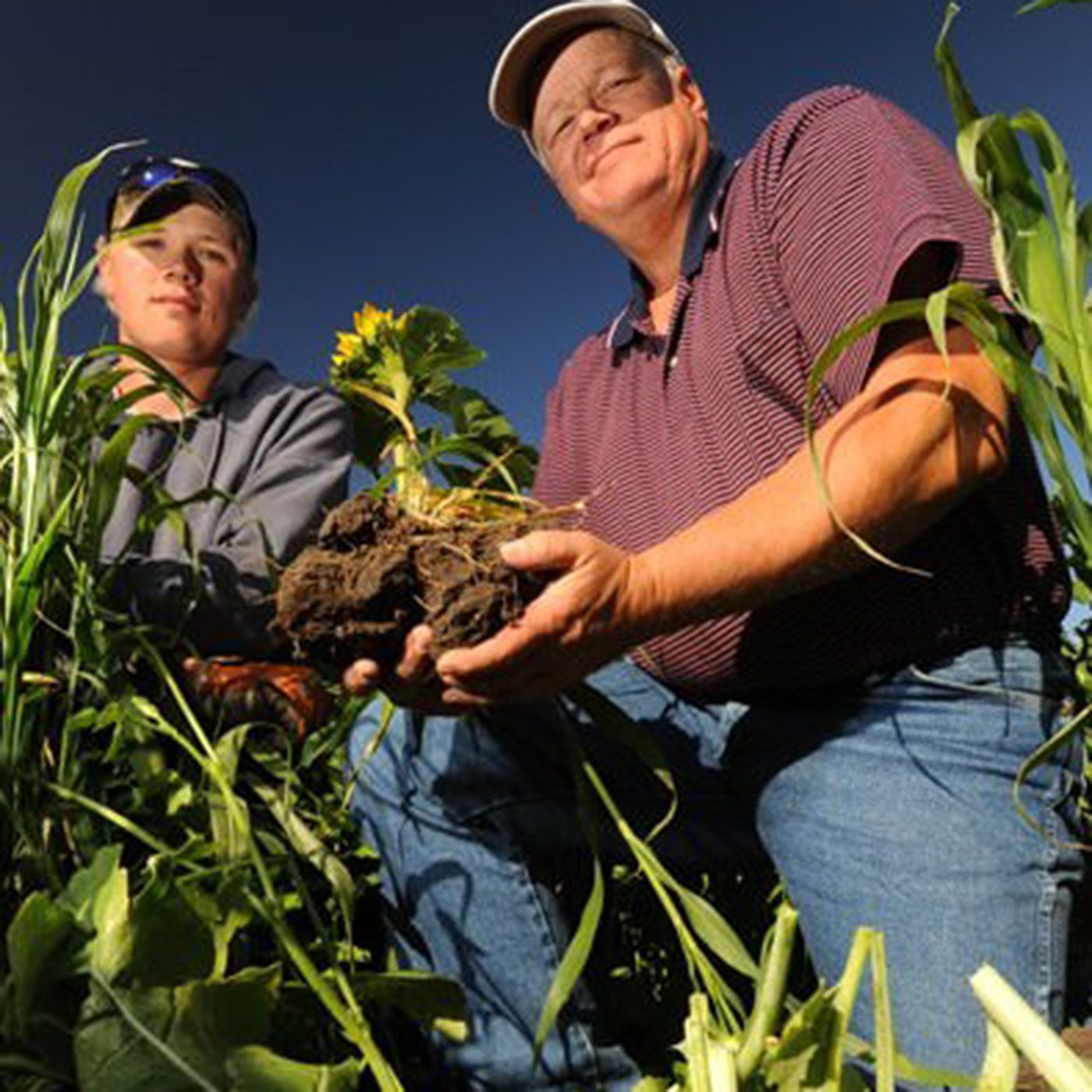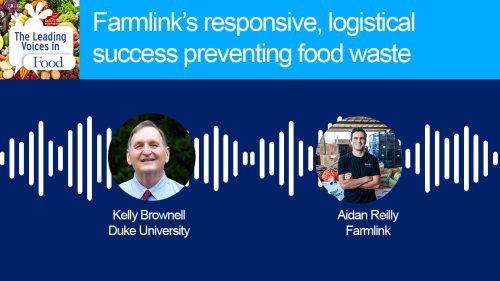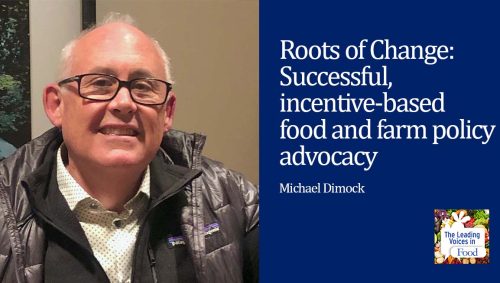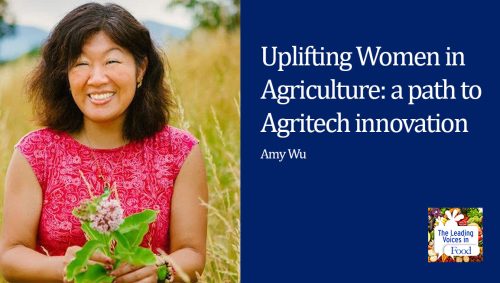The Leading Voices in Food
E69: Gabe Brown on the Desperate Need for Regenerative Agriculture
Imagine a farm doing such creative work that more than 2,000 people come to visit each year from all 50 states and more than 20 countries outside the US. What do you think such a farm might be doing? Our guest Gabe Brown can explain.
Subscribe: Apple Podcasts | TuneIN | YouTube Music | SoundCloud | PocketCasts | Radio Public
Tags: Agriculture & Tech | Climate Change, Environment & Food | Regenerative Agriculture | Voice of Farming |

Gabe Brown along with his wife Shelley and son Paul own and operate Brown’s ranch, a diversified 5,000 acre farm and ranch near Bismark, North Dakota. They are considered to be leaders in the current soil health movement, which focuses on regeneration rather than depletion of resources.
Interview Summary
First, can you describe your farm? 5,000 acres is huge. What do you grow and raise with all those acres?
Well, 5,000 acres on scale in the current production model in North Dakota is not so big. We’re an average size operation here and we run beef cattle, we grass finish beef, we have a flock of sheep and we grass finished lambs. We have pastured pork, we have about 1,400 laying hens out on pasture. We grow some fruit, some vegetables and then we do a fair amount of grains also. Everything from corn and peas and hard red spring wheat and oats and barley and winter triticale and rye. We also do some honey, we have some bees on our operation, so it’s a very diverse operation.
It’s very interesting to think about the scope of that and how all these pieces fit together and I know that you’ve spoken about your farm as an ecosystem. What do you mean by this?
Well, one of the things that I see is wrong, so to speak, with production agriculture today it is, it has become very singular and by that I mean producers, farmers, ranchers, they only have corn or they have corn and soybeans or they only have beef cattle or they only have dairy cattle. They specialize in one specific commodity. Whereas our operation, we have over 17 different enterprises. We have all these different cash crops and cover crops and livestock and that allows our operation to function more like an ecosystem.
And I explain to people, if you can imagine what the Northern Great Plains looked like centuries ago with these herds of bison moving across to the plains and they were being moved by predators and there was deer and elk and rabbits and all the insects. Well that’s kind of what it’s like on our operation in that we move our animals daily to different pastures or paddocks if you will, and it’s not only one species like the beef cattle we’re moving, but then we have the sheep and we have the laying hens and we have broiler chickens and we’ve got the bees and all these different enterprises, allows our ranch to act more like a natural ecosystem.
Is it fair to say that each piece of this benefits from the others in important ways?
That’s exactly right. And you look at how nature functions. In nature it’s not singular. You can’t change one thing without it having compounding or cascading effects. And these compounding, cascading effects are either positive or negative. And as you stack so to speak, enterprises, it’s going to benefit the resource as a whole. And that’s the reason we’ve been able to take large amounts of carbon out of the atmosphere and move them into the soil and have soils that are much more resilient to these swings in moisture and temperature. That’s how nature functions. That’s what we’re trying to mimic on our ranch.
Can you explain the concept of regenerative agriculture?
So I often get asked that question, what is regenerative agriculture? And I answer it this way, one of the current buzz words we hear so often as sustainable. Everyone wants to be sustainable. But in agriculture, the question I pose to people is, why would we want to sustain a degraded resource? And if you look at our resources and our ecosystem, how it functions today, it is degraded. The organic matter levels on our soils in production agriculture, I don’t care where you go in North America, around the world for that matter, it’s a mere fraction of what it once was.
Well, this has major ramifications when it comes to the amount of rainfall that can infiltrate into the soil and be held in the soil for when the plants need it. I say regenerative agriculture is bringing the ecosystem back into function so it can function in a way where it truly can sustain healthy life in the form of plants, animals, and then eventually people.
Gabe, can you give us a concrete example of regenerative agriculture? How you actually do this?
Sure. I give as an example what we’ve been able to do on our ranch. When my wife and I purchased this ranch from her parents in 1991, we could only infiltrate a half of an inch of rainfall per hour. That’s all that can infiltrate into the soils. And the reason it wasn’t more than that is because my father-in-law for years, he had tilled the soil, which is very destructive, destroys soil aggregates and it decreases water infiltration.
Well now today, on those same soils, we’re able to infiltrate an inch of rainfall in nine seconds and the second inch in 16 seconds. Soils that were once a half an inch an hour, we can now infiltrate two inches in 25 seconds. Well, think of the ramifications of that. Throughout much of the western US and southwestern United States, you see decrease in the amount of water in the aquifers and water is becoming a major issue. Well, if we’re able to infiltrate more rainfall and then store that in the soils via organic matter levels and on our operation, on our ranch in 1991, organic matter levels were 1.7 to 1.9%. And I use the word organic matter, think of it as carbon. Organic matter is approximately 58% carbon. Well, historically speaking in our area, organic matter levels should have been in the seven to 8% range.
Well we were less than 2% so in other words, 75% of the carbon had left the soils and where did it go? Well, it’s up in the atmosphere. Well, we need to bring that back down into the soil. Now today, those same fields that were less than 2% organic matter are now in the seven to 8% organic matter range. And in fact we have a team of scientists that are doing some major analysis of our soils and they found we now have 96 tons of carbon per acre stored in our soils. Well this is approximately four times what they thought that they would find here. When we hear about there being too much carbon in the atmosphere and we need to sequester it, so to speak, into the soils, well regenerative agriculture can do that. And the way that comes about is through the management practices or I like to call it the stewardship practices that we apply on our lands.
Boy, that is so impressive. Why do you think people are so fascinated by this work and want to learn more? And why should the general public care about this?
Well, what I see is you look at, and for lack of better word, just the ills in society today, look at what we’re seeing. We’re seeing major nitrification problems in the Gulf of Mexico, in our Great Lakes, in our estuaries, on the Chesapeake and on the West Coast. Well that’s too much nutrients are leaving the landscape from production agriculture and from industry, being put into the watersheds. Okay, if we heal, so to speak, the farms and ranches, if we grow cover crops, we’re able to hold those nutrients on those farms and ranches so they don’t end up in our watersheds and in our drinking water, in our oceans and rivers, streams.
That’s one small facet. Now you look at what’s happening from a human health aspect also, and we have a human health crisis in this country and around, it’s really occurring around the world. I tell people, the United States spends more on healthcare than any other country in the world per capita, yet I just saw figures yesterday, we’re now ranked the 35th healthiest country in the world. Well, why is that? Well, part of it’s due to our sedentary lifestyle, but part of it is due to the lack of nutrient density in our foods. Well, why don’t we have nutrient density in our foods? In order for a plant and eventually then an animal if that plant’s consumed by an animal, to be nutrient dense, you have to have a healthy functioning soil ecosystem because that’s the only way these plants will get all these plant secondary metabolites.
Well, how do we get a healthy soil? It’s through regenerative agriculture and using these principles. I don’t care, and then the third component we can say is the carbon in the atmosphere. Okay, we have way too much carbon in the atmosphere, not enough in our soils. How do we move carbon from the atmosphere down into the soils? It’s with living plants, whether it be cash crops, cover crops. But then a very, very important piece of the puzzle is those plants need to be grazed by animals because that grazing of these plants by animals then signals to plants to release more red exudates so they can start re-growing and they will take in more CO2 out of the atmosphere to pump more carbon into the soil. Animals are crucial to this. I don’t care which ill you’re talking about that we’re facing in society today, regenerative agriculture more than anything else, has the ability to move us in a positive direction.
Let’s say you take two farms across the road from one another and farm A uses traditional models, mass farming practices, farm B uses regenerative practices and they both grow carrots. Are you saying the carrots will have more nutrients on the regenerative farm because the soil has been treated better?
Absolutely. And there are several organizations out there now and businesses that are moving down the path to focus on this and to get the hard data to prove that that is so. We’ve known it for a long time, but more or less, it’s been anecdotal evidence, it’s tough to really be able to pay for the research to show just that. But now there’s businesses that are focused on it. Last week, General Mills announced that they’re putting some major funding into regenerative agriculture and it’s things like that, that they’re going to find out that we’re going to produce food that’s higher in nutrient density if it’s being grown on regenerative farms.
And is the taste of food affected as well?
Sure it is. It’s those plant secondary metabolites. One of the things, as you mentioned in the opening, we have visitors from all over the world coming here. And the one thing that they say when I visit with them, they say they can’t believe how terrible the food tastes here in the United States. And the reason for that is our production model. It’s such large scale and there’s not these plant secondary metabolites and it’s the plant secondary metabolites, the phenols, the alkaloids, the terpenes that really drive human taste and drive health. Whether it be health in a plant, in an animal or in us as human beings.
And when they come to my farm, we generally serve a meal to visitors and their eyes light up and they say, “This is real food.” And when I’m out speaking across the United States to individuals and organizations, I often make the comment that I really think that the vast majority of citizens in our country do not know what nutrient dense food tastes like because if they do taste it, they’ll go, wow, their body will send signals that this is good, I want more. And we’ve just, because of our production model and because of what consumers have dictated, it’s all about a cheap food policy and not about nutrient density and truly healthy food. They’ve come to accept that. And now we have generations that really don’t know what nutrient dense food tastes like.
Gabe, you probably just made all our listeners as I am hungry for some of that wonderful food. It sounds really good. Let’s talk about the model that you’re talking about. Do you think it’s exportable? Can it be used elsewhere in the US and around the world?
The beautiful thing about regenerative agriculture, and I tell people this, wherever in the world that you are, that you grow food with soil, regenerative agriculture can take place. And the beauty of it is I can pick up a phone and I can call friends in Australia and South Africa and Argentina and Sweden and Canada and Mexico, anywhere around the world, there’s people practicing regenerative agriculture because regenerative agriculture is based on five basic principles. And briefly those are number one, we need A to have armor on the soil at all times. The soil needs to be covered. You can’t see bare soil because then it’s prone to wind erosion, water erosion, evaporation.
We need diversity. We need diversity in both plants and animal life. Where in nature do you find monocultures? You don’t, usually only wear man put them. Otherwise nature is very, very diverse. You need a living root in the soil as long as possible. In other words, a growing plant. Look at our production model today farming. Farmers grow one crop and then the land sits idle for the majority of the year. That means there’s no sunlight being collected. We’re not taking carbon out of the atmosphere, pumping it into the soil.
And then we also need integration of animals and insects. So often farmers think of insects as pests, but they don’t realize for every insect species that’s a pest, there’s 1,700 that are beneficial. And why do we want to spend our time killing the one pest when we should be proliferating all the insect population? And then nature be in self-organizing, self-healing, self-regulating will take care of those imbalances. On our operation, we haven’t used a pesticide since before the turn of the century. There’s no need to because if you have a healthy functioning ecosystem, those insects will become in balance. And then you need the livestock integration and animal integration. And I’m talking about all farms, everything from beef cattle, to rabbits and chickens. And that’s how a healthy ecosystems function. And if you use nature’s template, this can take place anywhere in the world where there’s production agriculture on land.









